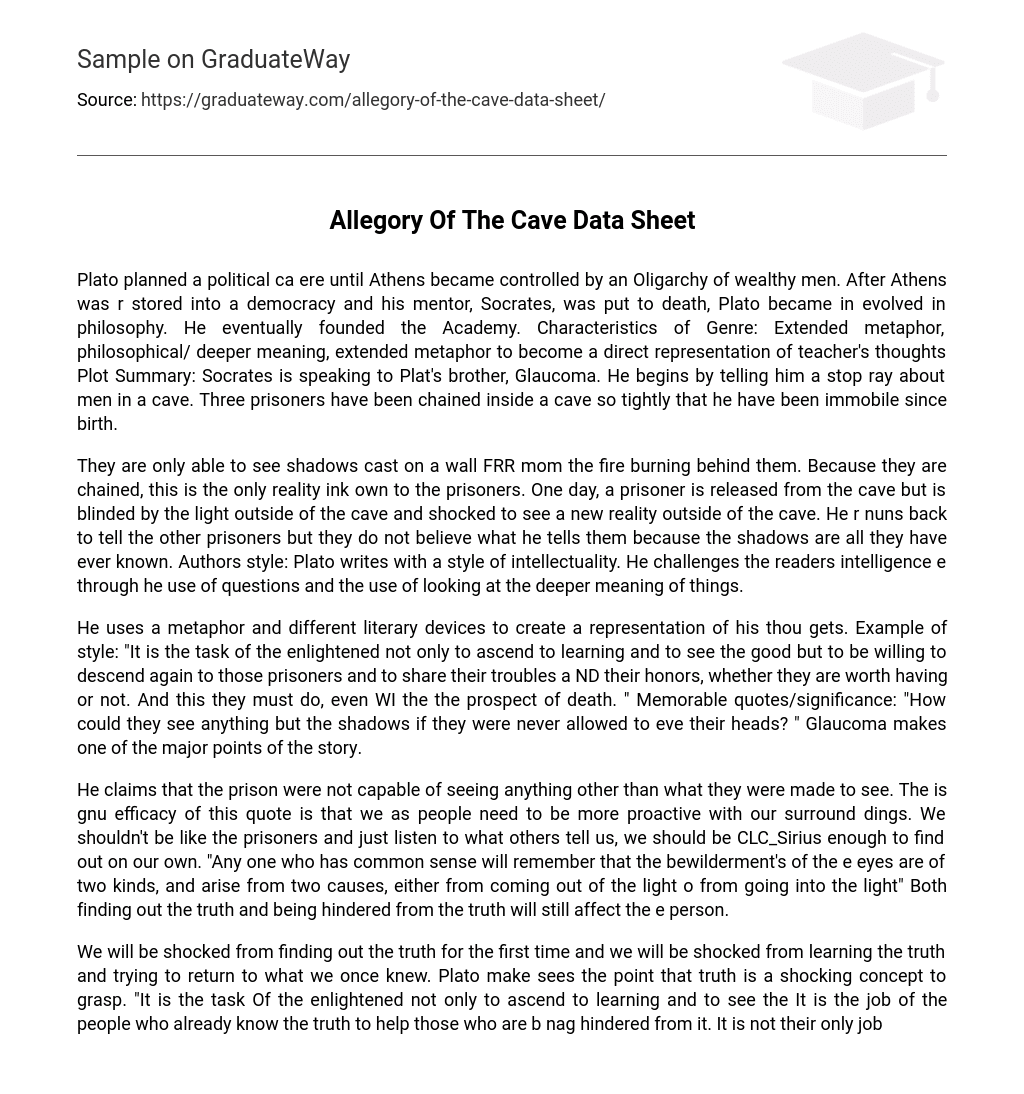Plato planned a political ca ere until Athens became controlled by an Oligarchy of wealthy men. After Athens was r stored into a democracy and his mentor, Socrates, was put to death, Plato became in evolved in philosophy. He eventually founded the Academy. Characteristics of Genre: Extended metaphor, philosophical/ deeper meaning, extended metaphor to become a direct representation of teacher’s thoughts Plot Summary: Socrates is speaking to Plat’s brother, Glaucoma. He begins by telling him a stop ray about men in a cave. Three prisoners have been chained inside a cave so tightly that he have been immobile since birth.
They are only able to see shadows cast on a wall FRR mom the fire burning behind them. Because they are chained, this is the only reality ink own to the prisoners. One day, a prisoner is released from the cave but is blinded by the light outside of the cave and shocked to see a new reality outside of the cave. He r nuns back to tell the other prisoners but they do not believe what he tells them because the shadows are all they have ever known. Authors style: Plato writes with a style of intellectuality. He challenges the readers intelligence e through he use of questions and the use of looking at the deeper meaning of things.
He uses a metaphor and different literary devices to create a representation of his thou gets. Example of style: “It is the task of the enlightened not only to ascend to learning and to see the good but to be willing to descend again to those prisoners and to share their troubles a ND their honors, whether they are worth having or not. And this they must do, even WI the the prospect of death. ” Memorable quotes/significance: “How could they see anything but the shadows if they were never allowed to eve their heads? ” Glaucoma makes one of the major points of the story.
He claims that the prison were not capable of seeing anything other than what they were made to see. The is gnu efficacy of this quote is that we as people need to be more proactive with our surround dings. We shouldn’t be like the prisoners and just listen to what others tell us, we should be CLC_Sirius enough to find out on our own. “Any one who has common sense will remember that the bewilderment’s of the e eyes are of two kinds, and arise from two causes, either from coming out of the light o from going into the light” Both finding out the truth and being hindered from the truth will still affect the e person.
We will be shocked from finding out the truth for the first time and we will be shocked from learning the truth and trying to return to what we once knew. Plato make sees the point that truth is a shocking concept to grasp. “It is the task Of the enlightened not only to ascend to learning and to see the It is the job of the people who already know the truth to help those who are b nag hindered from it. It is not their only job to learn the truth but to share it with o hers so that they may know the truth as well.
It is the job of the enlightened to do this eve n with the possibility of trouble. Plato wants to make a point that everyone should event ally learn truth. “Most people, including ourselves, live in a world of relative ignorance. We are comfortable with that ignorance, because it is all we know. When we first start facing truth, the process may be frightening, and many people run back to their Old ivies. But if you continue to seek truth, you will eventually be able to handle it better. In FAA CT, you want more!
It’s true that many people around you now may think you are wee rd or even a danger to society, but you don’t care. Once you’ve tasted the truth, you won ‘t ever want to go back to being ignorant” Plato uses Socrates to make the point that though the truth may be shocking, it is better to know truth than live in a world of ignorance. We as people love ignorance b cause it’s what we’ve always known and we are comfortable with it. The more you SE eek truth the less scary it gets. And once you’ve known truth you will never want to be I anorak again. Characters (name, role, sign efficacy, adjectives):
Socrates: Plat’s teacher, the philosopher telling the Story to his student, very intellectual, narrator of the metaphor, leads audience to conclusions through structured questions Glaucoma: The brother of Plato, interlocutor, serves as a receiver of the inform action, asks questions to Socrates to help portray the knowledge for the reader, audience Free man: The philosopher in the allegory, intellectually advanced, sees beyond d the empirical world Prisoner: Metaphor to the common man, cannot see past the empirical world, does not understand the concept of knowledge beyond it
Setting: The cave or the world of sight/ignorance //The House of Cephalic Significance of opening scene: Socrates asks Glaucoma to imagine a cave of prisoners that are chained up and have been immobilizers since birth. They are only able to gaze at the wall in front Of them. Socrates is setting up the scene for the entire allegory. He is creating an image e of which he will use as a metaphor to knowledge, the overall purpose of the allegory. H e uses an allegory to demonstrate the effects and importance of education for the Phil gopher. Symbols/motifs:





